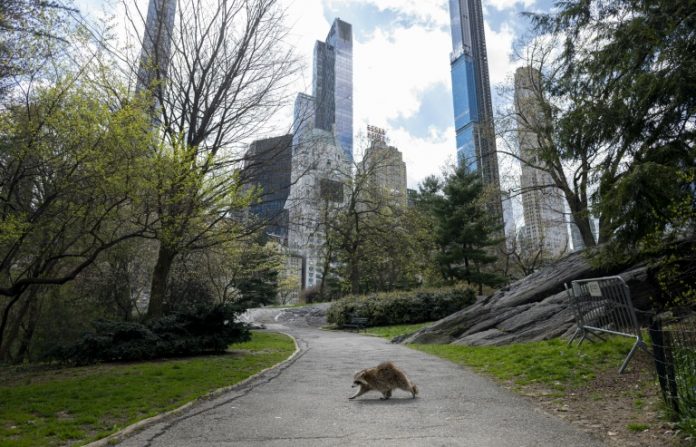Gone are the softball games, horse-drawn carriages and hordes of tourists. In their place are pronounced birdsong, solitary walks and renewed appreciation for Central Park’s beauty during New York’s coronavirus lockdown.
The 843-acre (340-hectare) park – arguably the world’s most famous urban green space – normally bustles with human activity as winter turns to spring
But this year due to COVID-19, it’s the wildlife that is coming out to play.
“The energy is quiet, you hear the birds, you hear the wind differently,” 66-year-old former ballet dancer Timothy Foster told AFP, while walking his dog Charlie near the park’s Belvedere Castle.
– ‘Disturbing’ –

More than 40 million people visit Central Park every year, bringing with them a hive of commercial pursuits including guided pedicab tours, snack vendors, buskers and breakdancing troupes.
Many come to play music at the Strawberry Fields memorial for late Beatle John Lennon or pose for photos in front of a fountain that resembles the one in the opening credits of hit TV show “Friends.”
But since mid-March, when New Yorkers were ordered to practice social distancing as the city became America’s coronavirus epicenter, the park has become a place for quick walks alone and somber reflection rather than a spot for picnics and noisy team sports.

“It’s a lot quieter, which is nice. But it’s also disturbing to have it not be overrun with people like it normally is,” 45-year-old writer Carol Hartsell told media
Most surreal is the sight of a 12-tent, 68-bed field hospital on a small section of lush lawn on the park’s eastern border, set up to treat coronavirus patients from nearby hospitals.
The virus has killed more than 12,000 people in New York state, out of more than 223,000 known infections.

The outbreak has coincided with the blooming of Central Park’s cherry blossom and crabapple trees, as well as North America’s spring bird migration.
Yellow pine warblers and blue-gray gnatcatchers frolic near pink and white magnolias and red maple trees, free of the typical background hum of traffic and planes overhead.
– Raccoons –
“You can hear more calling, more singing,” said David Barrett, author of a book about the 200 bird species that spend time in Manhattan every year.
“There are fewer people, fewer dogs so the birds are not being frightened,” he told reporters.
And it’s not just the birds that are feeling braver.
When reporters visited the park early one recent afternoon, a raccoon took advantage of a quiet road normally packed with runners and cyclists to amble across in its own sweet time.

Central Park was designed by architects Frederick Law Olmsted and Calvert Vaux in the 1850s to provide New Yorkers with a green oasis to escape the stresses of urban life and connect with nature.
More than a century and half later, with museums, theaters, cinemas and shops closed, it is one of the few places in New York still open – a destination for residents who want a break from their cramped apartments.
– ‘Lifesaver’ –
“The park is really fulfilling its original purpose,” said Elizabeth Smith, CEO of the Central Park Conservancy, a non-profit that maintains the park.
“Almost everyone that comes up to me says thank goodness for the park, what would we do without it? It has been a lifesaver for so many people,” she told our news reporters
This week, Governor Andrew Cuomo extended New York’s shutdown – which orders residents to stay at home except to exercise and perform other essential business – until May 15.

Didi Nitta, 75 and with binoculars hanging round her neck, said the crisis has highlighted how essential Central Park is for her mental and physical well-being.
“It’s delightful for your soul. Manhattan without this park is unimaginable,” she said.












